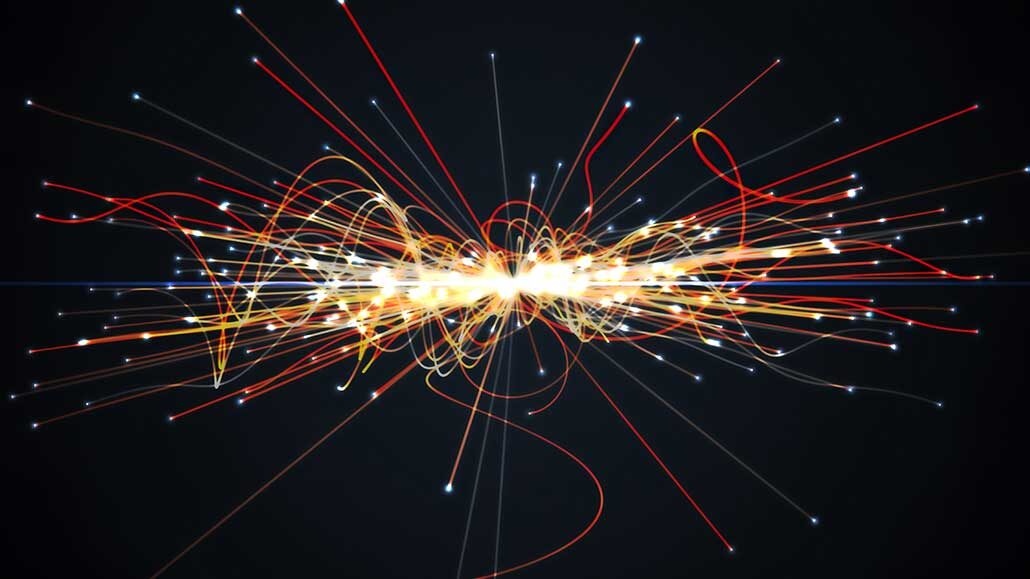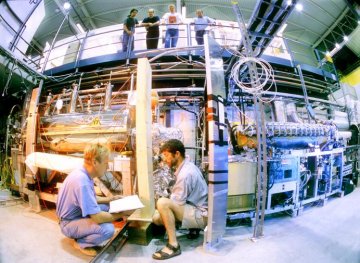The Mirror Universe of Antimatter
Scientists are creating particles of antimatter to learn why the universe has so few.

Scientists often create antimatter by colliding beams of particles together in large instruments known as accelerators. Here’s an artist’s rendering of what such a smashup might look like.
Vchal/iStock/Getty Images Plus
Share this:
- Share via email (Opens in new window) Email
- Click to share on Facebook (Opens in new window) Facebook
- Click to share on X (Opens in new window) X
- Click to share on Pinterest (Opens in new window) Pinterest
- Click to share on Reddit (Opens in new window) Reddit
- Share to Google Classroom (Opens in new window) Google Classroom
- Click to print (Opens in new window) Print
By Emily Sohn
Had a fight with your parents or a bad day at school? Wouldn’t it be nice to step through a mirror to enter a different, yet somehow familiar world on the other side?

In some ways, this might not be such a farfetched idea. Physicists around the world are using high-tech machines to make particles of so-called antimatter. They think of antiparticles as mirror images of the particles that make up everything in our everyday world. A particle and its antiparticle are identical, except that they have opposite electrical charges.
The new research probably won’t turn up anything exotic — certainly nothing like a galactic wormhole that would let you slip instantly from one part of the universe to another. Studying antimatter, however, could help scientists understand the origins and makeup of the universe. And particles of antimatter already play an important part in the machines used to scan the brain to monitor mental activity.
Ordinary matter
Few people have ever seen antimatter. Most of them are cutting-edge physicists. The rest of us are much more familiar with matter. Everything we see, touch, eat, drink and breathe is made up of tiny objects called atoms. Atoms, in turn, are made up of even tinier particles: electrons, protons, and neutrons.
Electrons have a negative electrical charge. Protons have a positive electrical charge. Neutrons have no electrical charge. A typical atom is made of equal numbers of electrons and protons, along with some neutrons. How many protons an atom has determines what kind of atom it is. A hydrogen atom, for example, consists of just one proton and one electron.
Each type of particle has an elusive anti-partner. An antiproton is just like a proton, except it has a negative charge. A positron is just like an electron, but with a positive charge. However, when a proton meets an antiproton or an electron meets a positron, the particles destroy each other. They disappear in a puff of energy.
As bizarre as the concept may sound, scientists have known about antiparticles for decades.
“When I talk about antimatter to my colleagues, they are not very excited about it. They say, ‘Okay, so what’s new? What are you doing with it?'” says Rolf Landua. He’s a physicist at CERN in Geneva, Switzerland. “When I talk to nonphysicists about it, they look at me with great eyes and say, ‘God, it sounds so exotic.'”
Making antimatter
At CERN, Landua works with a group called the ATHENA collaboration. These physicists were the first to succeed in linking positrons with antiprotons to make atoms of antihydrogen. It’s the simplest anti-atom.
 |
|
Rolf Landua stands at the entrance to the Antiproton Decelerator (AD) control room.
|
| © CERN |
In theory, the process of making antimatter is fairly simple. In fact, the equipment needed to do it can be very complicated (and expensive).
Scientists at CERN use a one-of-its-kind machine to make antiparticles. When created, these antiparticles typically have a whole lot of energy. Inside the machine, they zoom along circular tunnels, making a million circuits every second. But on each lap, the tiny objects pass through magnetic and electric fields that slow them down. Once the antiparticles have stopped moving, the researchers can store and then combine them.
“We now have the first antiatom ever produced by humans,” Landua says. “That’s the new thing about our experiment.”
Beginning of time
Besides being mind-bafflingly strange, human-made bits of antimatter may provide windows into the very beginning of time.
One of the big mysteries of the universe, Landua says, is that it doesn’t appear to contain any antimatter. “You probably don’t spend sleepless nights wondering about why that is,” he says. “But physicists do.”
Here’s one reason for pondering antimatter. Many physicists think that, if the universe started with a giant burst of energy called the Big Bang, it should have produced equal amounts of matter and antimatter.
But, whenever matter meets antimatter, the particles annihilate each other and disappear. So, during the very first millisecond after the Big Bang, the two types of particles should have canceled each other out.
Instead, perhaps because there was slightly more matter than antimatter in the beginning, only the antimatter disappeared, and our matter-full universe was able to form out of the leftovers. Landua and his colleagues want to find out what might have caused an imbalance.
“We study anti-atoms, and we compare them with atoms to see if there are any differences — even the tiniest ones,” Landua says. “This is a big question because, if there was no [imbalance] between matter and antimatter, we wouldn’t exist.”
Slow going
Progress is slow. With current technology, ATHENA researchers can make 100 antihydrogen atoms every second. At that rate, making 1 gram of the stuff would take many billions of years—longer than the age of the universe itself.
 |
|
It takes an enormous machine and lots of equipment to create antimatter.
|
| © CERN |
It’s also extremely hard to store antimatter because it gets destroyed as soon as it comes into contact with matter, which is everywhere. The researchers are trying to figure out how to make more antiatoms faster, trap them better, and hold onto them for longer periods of time.
The possibility also remains that some chunk of antimatter might exist elsewhere in outer space in the form of anti-stars or antigalaxies, Landua says. So far, searches of our universe have turned up nothing, but Landua hasn’t given up hope.
“There may be other universes we cannot look into where there is a preponderance of antimatter,” he says. “At least here, in our section of the universe, it doesn’t seem like it. This is the mystery.”
So, being able to step into an alternative mirror universe to get away from your troubles will probably remain a long shot for a long time to come.
Going Deeper:







